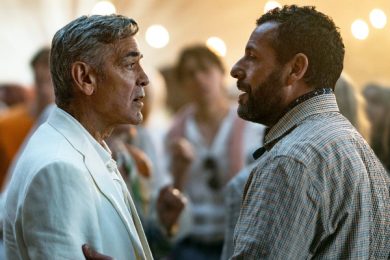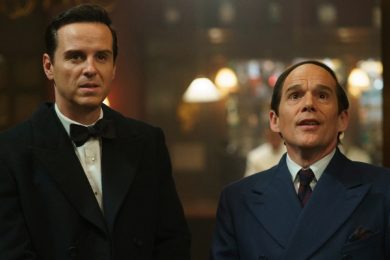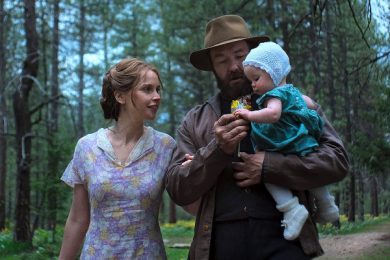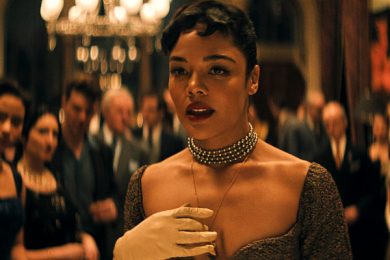Twisters is something less than a remake and something more than a sequel. It carries over none of the characters from the 1996 film Twister, but its spirit – and structure – recalls the regality of the 90s studio blockbuster. In the ’96 film, Helen Hunt played a science-driven storm chaser formed by tragedy, and her love interest was an adrenaline-seeking Bill Paxton. Twenty-eight years later, those roles are transposed to Daisy Edgar-Jones and Glen Powell, two young actors daring to become movie stars against the trends of current industry wisdom. Twisters is directed by Lee Isaac Chung, the Oscar-nominated director behind 2020’s Minari, an indie immigrant story that wouldn’t exactly suggest the chops of a Hollywood blockbuster filmmaker. This ends up being the perfect brew for the best studio movie of the summer.
Edgar-Jones, a British actress with limited but successful credits across movies and television, is given her biggest vote of Hollywood confidence here. She plays Kate Cooper, a storm chaser and Oklahoma native looking for a way to kill tornadoes. She’s been experimenting with different techniques since she was in middle school. In college, she develops a solution of sodium polyacrylate, which she hopes can choke the storm and stop it from mass destruction. Nearly clairvoyant, she guides her group of student chasers toward a low-level tornado to test her theory and win them the grant money that will make her theory a reality. But what she thinks is an EF1 tornado is actually an EF5, and the storm builds in strength, killing nearly all of them except for her and her fellow scientist, Javier (Anthony Ramos).
Years later, Kate is living in New York and working for the National Weather Service. Javier comes to visit her to tell her that he’s working with a new company that can get real tornado data that can help them save lives. But he needs Kate’s help, which means returning to the storm chase that has left her traumatized. Reluctantly, she returns to her home state. Javier’s team, Storm Par, is corporate-financed with the highest level of sophistication and all the latest technology. Who’s putting up all the money? The less known about that the better. One practical problem are all the amateur chasers who fill up tornado alley. They are all obsessed with one chaser in particular: Tyler Owens (Powell), a storm chasing cowboy and YouTube rock star. A self proclaimed “tornado wrangler”, Tyler drives a big truck, blasting various sorts of Americana. If Storm Par is the steak, Tyler is the sizzle.
Tyler’s ragtag crew (a terrific ensemble including a wide variety of character actors, such as Brandon Perea, Sasha Lane, Katy O’Brian, and Tunde Adebimpe) are fun-loving partiers, and Tyler is their unapologetic leader. But the bombastic tornado wrangler does have his degree in meteorology, and he notices straightaway how much Kate knows about the storms. A healthy rivalry develops between Kate and Tyler, exacerbated by their diverging personalities and performance tactics in the field. Kate and Storm Par are searching for important data, Tyler and the wranglers are trying to put on a show. With a truck that drills two feet into the ground’s surface, the wranglers can plant themselves underneath a tornado and shoot off fireworks. Meanwhile, Storm Par seek to triangulate their devices to get a proper 3-D scan of the twisters, making a graph of their foundation.
The script is written by veteran Mark L. Smith, with a story credit given to Top Gun: Maverick director Joseph Kosinski. The screenplay is a feat of structure, rather than substance, and like its 90s predecessor, the movie’s more science-based monologues are cut with Save-the-Cat tropes that oversimplify things for any audience member who may feel alienated. Smartly, Chung mostly leans on the intensity of his disaster sequences and the chemistry of his cast to captivate the audience. With cinematographer Dan Mindel, he shot the film on 35mm film, a fact they haven’t been shy to promote. The decision pays dividends as Twisters is that rare thing in the 20s: a Summer blockbuster that actually looks very good. The vast landscape of middle America lends handsome imagery, sure, but Chung’s rendering of these wrathful storms are as magisterial as they are terrifying.
Twisters certainly owes much to the previous film, and the foundational elements of the story are similar enough, that Twister fans will be pleased. But Twisters does end up becoming something closer to its own unique experience. For one, Twisters takes a larger accounting of the damage that tornadoes do to the public at large, using long sequences to showcase the devastated homes and the public left scrambling with nowhere else to go. As the story unfolds, the wranglers prove to have more humanitarian substance to their operation than previously thought, while inversely, the benefactor to all of Storm Par’s gadgets ends up being less than philanthropic. It’s a switch most moviegoers will see coming, along with Kate and Tyler’s rivalry morphing into mutual respect, and then romantic tension.
Chung is unafraid to confront the socioeconomic realities of tornadoes (and how its victims seldom look as white as Kate or Tyler), even if the film is ultimately a tension-packed disaster flick without a political agenda. When the movie’s big final set piece ends up taking place in an old movie house, we understand that Chung is telling us that this is entertainment, first and foremost. But this is entertainment made with an extreme competence, that never plays down to its audience and never cheapens the essence of its characters. The tornado sequences are upsetting both in their immediacy and in their aftermath, and Chung showcases skill on a scale that just wasn’t possible in films like Minari. If Jan de Bont (director of Twister) is the ideal of action movie filmmaking in the 1990s, then Lee Isaac Chung is showing us an ideal for what we can do in the 2020s.
Directed by Lee Isaac Chung










